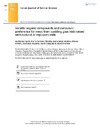Identificador persistente para citar o vincular este elemento:
https://accedacris.ulpgc.es/handle/10553/70006
| Campo DC | Valor | idioma |
|---|---|---|
| dc.contributor.author | Ripoll, Guillermo | en_US |
| dc.contributor.author | Córdoba, María de Guía | en_US |
| dc.contributor.author | Alcalde, María Jesús | en_US |
| dc.contributor.author | Martín, Alberto | en_US |
| dc.contributor.author | Argüello Henríquez, Anastasio | en_US |
| dc.contributor.author | Casquete, Rocío | en_US |
| dc.contributor.author | Panea, Begoña | en_US |
| dc.date.accessioned | 2020-02-05T12:51:52Z | - |
| dc.date.available | 2020-02-05T12:51:52Z | - |
| dc.date.issued | 2019 | en_US |
| dc.identifier.issn | 1594-4077 | en_US |
| dc.identifier.other | Scopus | - |
| dc.identifier.uri | https://accedacris.ulpgc.es/handle/10553/70006 | - |
| dc.description.abstract | Most of European Union goats are slaughtered with carcase weights between 5 kg and 11 kg. Some farmers rear kids with milk replacers to produce cheese with the dams’ milk. The aim of this experiment was to study the volatile compounds (VOCs) of meat of suckling light kids reared with natural milk or milk replacers and to study the influence of consumers’ psychographic characteristics on the sensory preference for meat. Gas chromatography-mass spectrometry was performed to identify the VOCs and consumers evaluated the flavour, juiciness and overall acceptability. Thirty-five VOCs were detected and 44.3%, 25.1%, 6.9% and 2.3%, were aldehydes, hydrocarbons, ketones and alcohols, respectively. The influence of the rearing system on VOCs clearly depended on the breed. The use of milk replacers did not affect the percentage of linear aldehydes compared to the use of natural milk. However, the major aldehyde, hexanal (34.8%), was related to the use of natural milk and correlated positively with both the flavour (r = 0.21) and overall acceptability (r = 0.24). On the other hand, hydrocarbons such as hexane were related to MR, and 2-methyl-pentane and 3-methyl pentane were correlated with the acceptability of flavour (r = −0.22 and −0.25, respectively) and with the overall acceptability (r = −0.21 and −0.24). The 2-penthyl furan and 2-ethyl-1-hexanol were correlated with the overall acceptability (r = −0.22 and −0.22, respectively). Therefore, the acceptability of meat from suckling kids fed natural milk was greater for older consumers and people with a moderate consumption of meat.Highlights Goat farmers remove the kids from their dams at a very young age and rear them with milk replacers, but this practice may alter the flavour of meat. The major aldehyde, hexanal, was related to the use of natural milk and correlated positively with the flavour and overall acceptability. Acceptability of meat from suckling kids fed natural milk was greater for older consumers and people with a moderate consumption of meat. | en_US |
| dc.language | eng | en_US |
| dc.relation.ispartof | Italian Journal of Animal Science | en_US |
| dc.source | Italian Journal of Animal Science [ISSN 1594-4077], v. 18 (1), p. 1259-1270 | en_US |
| dc.subject | 3104 Producción Animal | en_US |
| dc.subject.other | Food Chemistry | en_US |
| dc.subject.other | Goats | en_US |
| dc.subject.other | Meat Composition | en_US |
| dc.subject.other | Meat Flavour | en_US |
| dc.subject.other | Meat: Sensory Score | en_US |
| dc.title | Volatile organic compounds and consumer preference for meat from suckling goat kids raised with natural or replacers milk | en_US |
| dc.type | info:eu-repo/semantics/Article | en_US |
| dc.type | Article | en_US |
| dc.identifier.doi | 10.1080/1828051X.2019.1646107 | |
| dc.identifier.scopus | 85070806981 | - |
| dc.identifier.isi | 000479228800001 | |
| dc.contributor.authorscopusid | 23968109200 | - |
| dc.contributor.authorscopusid | 7005697475 | - |
| dc.contributor.authorscopusid | 7003518858 | - |
| dc.contributor.authorscopusid | 7404932754 | - |
| dc.contributor.authorscopusid | 6701710018 | - |
| dc.contributor.authorscopusid | 30367602800 | - |
| dc.contributor.authorscopusid | 6602659752 | - |
| dc.description.lastpage | 1270 | - |
| dc.identifier.issue | 1 | - |
| dc.description.firstpage | 1259 | - |
| dc.relation.volume | 18 | - |
| dc.investigacion | Ciencias de la Salud | en_US |
| dc.type2 | Artículo | en_US |
| dc.contributor.daisngid | 30424985 | |
| dc.contributor.daisngid | 402805 | |
| dc.contributor.daisngid | 7608793 | |
| dc.contributor.daisngid | 482129 | |
| dc.contributor.daisngid | 298051 | |
| dc.contributor.daisngid | 31650075 | |
| dc.contributor.daisngid | 30553912 | |
| dc.utils.revision | Sí | en_US |
| dc.contributor.wosstandard | WOS:Ripoll, G | |
| dc.contributor.wosstandard | WOS:Cordoba, MD | |
| dc.contributor.wosstandard | WOS:Alcalde, MJ | |
| dc.contributor.wosstandard | WOS:Martin, A | |
| dc.contributor.wosstandard | WOS:Arguello, A | |
| dc.contributor.wosstandard | WOS:Casquet, R | |
| dc.contributor.wosstandard | WOS:Panea, B | |
| dc.date.coverdate | Enero 2019 | |
| dc.identifier.ulpgc | Sí | es |
| dc.description.sjr | 0,534 | |
| dc.description.jcr | 1,805 | |
| dc.description.sjrq | Q2 | |
| dc.description.jcrq | Q1 | |
| dc.description.scie | SCIE | |
| item.grantfulltext | open | - |
| item.fulltext | Con texto completo | - |
| crisitem.author.dept | GIR IUSA-ONEHEALTH 4. Producción y Biotecnología Animal | - |
| crisitem.author.dept | IU de Sanidad Animal y Seguridad Alimentaria | - |
| crisitem.author.dept | Departamento de Patología Animal, Producción Animal, Bromatología y Tecnología de Los Alimentos | - |
| crisitem.author.orcid | 0000-0002-4426-0678 | - |
| crisitem.author.parentorg | IU de Sanidad Animal y Seguridad Alimentaria | - |
| crisitem.author.fullName | Argüello Henríquez, Anastasio | - |
| Colección: | Artículos | |
Citas SCOPUSTM
13
actualizado el 08-jun-2025
Citas de WEB OF SCIENCETM
Citations
11
actualizado el 08-jun-2025
Visitas
68
actualizado el 24-feb-2024
Descargas
75
actualizado el 24-feb-2024
Google ScholarTM
Verifica
Altmetric
Comparte
Exporta metadatos
Los elementos en ULPGC accedaCRIS están protegidos por derechos de autor con todos los derechos reservados, a menos que se indique lo contrario.
